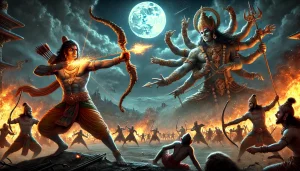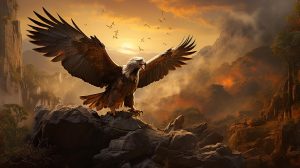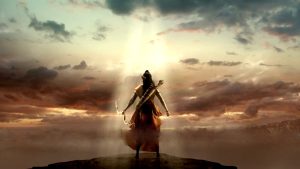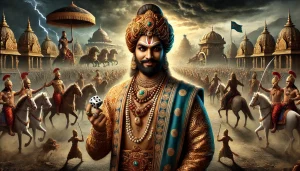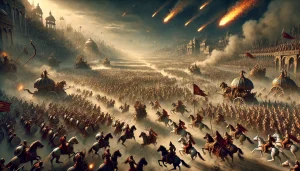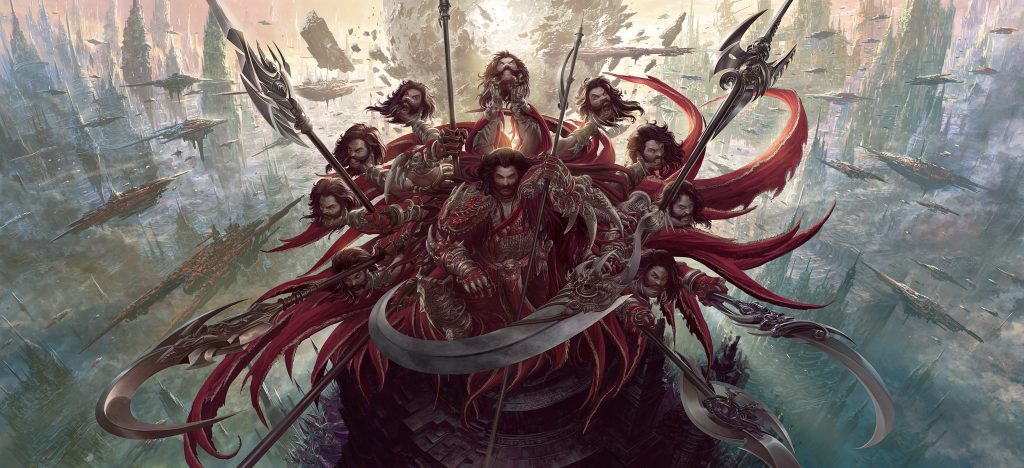
Ravana is a demon king and a prominent figure in the Hindu mythology, best known as the primary antagonist in the ancient Indian epic, the Ramayana.He is depicted as the powerful and learned king of Lanka, with a complex character that combines both demonic and regal qualities. Ravana is traditionally described as having ten heads and twenty arms, symbolizing his immense power and knowledge. He is a great devotee of Lord Shiva and is known for his prowess in warfare, as well as his mastery of various arts and sciences.
Ravana is a multifaceted character in Hindu mythology, embodying both the virtues and vices that make him a complex and enduring figure. His story is central to the Ramayana, one of the two major Sanskrit epics of ancient Indian literature.
Ravana was born to the sage Vishrava and the demon princess Kaikesi, making him a half-demon (rakshasa) and half-Brahmin. His siblings include Vibhishana, Kumbhakarna, and the sister Shurpanakha. Despite his demonic heritage, Ravana is often depicted as a learned and devout individual, well-versed in the Vedas and other sacred texts.
Ravana’s strength and near-immortality are attributed to boons granted by the gods Brahma and Shiva. After performing severe penances and austerities, he was granted several boons, including invincibility against gods and demons, although he neglected to seek protection from humans and animals, which ultimately led to his downfall.
Ravana ruled over the kingdom of Lanka, which is often described as a paradise with unparalleled riches and advanced architecture. His reign was marked by prosperity and cultural advancements, and he was a just ruler to his subjects, earning their loyalty and respect.
While Ravana is primarily seen as a villain in the Ramayana, his character is not entirely black and white. He is portrayed as a devoted follower of Lord Shiva, and his ten heads symbolize his vast knowledge and intelligence. In some interpretations, these heads represent his command over the four Vedas and six Upanishads, or his possession of the ten characteristics of a complete human being.
The central conflict in the Ramayana arises from Ravana’s abduction of Sita, Rama’s wife. This act is driven by a combination of lust, pride, and a desire for revenge against Rama and his allies. Ravana’s kidnapping of Sita leads to an epic battle between his forces and those of Rama, who is aided by his loyal brother Lakshmana and an army of monkeys led by Hanuman.
Ravana’s downfall is brought about by his hubris and his failure to heed wise counsel. Despite warnings from his brother Vibhishana and others, he refuses to return Sita, leading to a protracted war. Ultimately, Ravana is killed by Rama, who is an incarnation of the god Vishnu, symbolizing the triumph of good over evil.
Ravana remains a significant figure in Indian culture and mythology. He is sometimes viewed as a tragic hero whose downfall was brought about by his excessive pride and desire. In certain traditions, he is revered for his devotion to Shiva and his scholarly achievements. His story continues to be retold in various forms of art, literature, and performance, underscoring his enduring legacy.
Ravana’s ten heads are often interpreted as symbols of his vast intellect and capability, but they also represent his uncontrolled desires and arrogance. His character embodies the duality of good and evil, making him a timeless symbol of the complexities of human nature.
